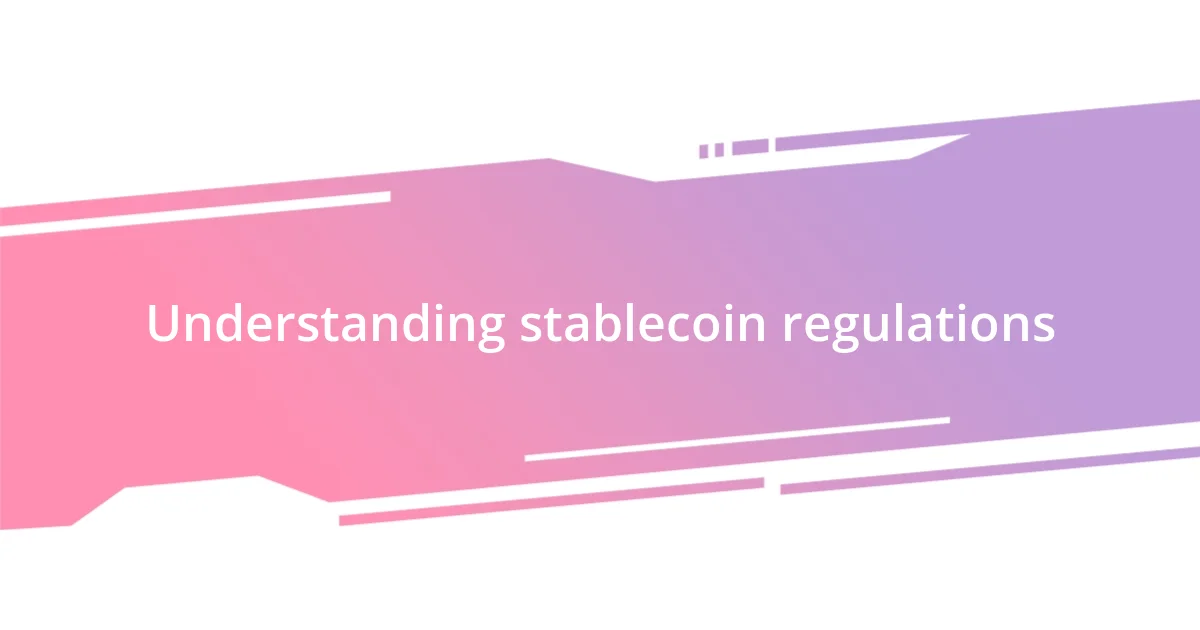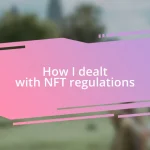Key takeaways:
- Understanding the rapidly evolving stablecoin regulations is essential for innovation and consumer protection, creating a need for adaptability among stakeholders.
- Proactive engagement with regulators can clarify compliance expectations and foster supportive relationships, minimizing risks associated with sudden regulatory shifts.
- Implementing best practices, including continuous improvement, documentation, and scenario planning, strengthens compliance frameworks and operational resilience in stablecoin projects.

Understanding stablecoin regulations
Stablecoin regulations are complex and constantly evolving, driven by the need for security and transparency in the crypto space. I often find myself asking, how can we foster innovation while ensuring consumer protection? It’s a delicate balance that regulators are striving to achieve.
From my experiences attending industry conferences, I’ve seen firsthand how different jurisdictions interpret regulations, leading to a patchwork of rules that can confuse even the most seasoned investors. In conversations with fellow enthusiasts, I hear a mix of optimism and concern about how these regulations will shape the future of stablecoins. Do we see them as a bridge to mainstream adoption, or do the regulations risk stifling the innovation that made them appealing in the first place?
Reflecting on this, I realize that the rapidly changing regulatory landscape pushes us to stay informed and adaptable. As someone passionate about the potential of stablecoins, I often wonder about the implications of these regulations on user experience and trust. What good is a stablecoin if the very framework supporting it creates uncertainty?

Identifying regulatory risks
Identifying regulatory risks in the stablecoin space can feel like navigating a maze. I remember attending a workshop where an expert highlighted the nuances between different regulations across regions. It struck me how one simple aspect, like the definition of a stablecoin, could trigger a cascade of compliance requirements. Different countries are also at varying stages of implementing regulations, which adds another layer of complexity for those involved.
The challenge lies in the unpredictability of regulatory timelines and the lack of uniformity. For instance, I recall speaking with a business owner who invested heavily in a stablecoin project, only to face delays due to sudden regulatory changes in their jurisdiction. It’s critical to have a keen sense of awareness around these shifts, as regulatory bodies may impose sudden changes that can impact project viability overnight.
Through my observations and experiences, I’ve also noticed that maintaining open channels of communication with regulators can ease some of these risks. Engaging in dialogue can provide insights and sometimes even lead to favorable outcomes for projects. Have you ever considered how proactive communication might shield you from unexpected compliance challenges? Based on my experience, this approach can make all the difference in identifying and managing regulatory risks effectively.
| Risk Factor | Industry Insight |
|---|---|
| Differing Definitions | Variations in how stablecoins are classified can lead to confusing regulations. |
| Changing Compliance Landscapes | Frequent regulatory updates create uncertainty for projects and investors alike. |
| Proactive Engagement | Conversing with regulators can provide early warnings and clarity on compliance. |

Assessing compliance frameworks
Assessing compliance frameworks is essential for navigating the complex regulations governing stablecoins. I vividly recall a time when a colleague shared a case study about a project that thrived because it invested time in understanding the local compliance framework. This proactive approach not only helped them meet regulatory requirements but also fostered trust with users and investors. I’ve found that aligning with these frameworks often proves invaluable, turning potential obstacles into strategic advantages.
When delving into compliance frameworks, consider these critical factors:
- Regulatory Alignment: Ensure that your project aligns with the specific regulations of the jurisdiction in which you operate.
- Transparency Practices: Adopt transparent practices that can bolster user trust and keep regulators informed about your operations.
- Adaptability: Stay flexible and ready to adapt to changes in regulatory requirements as the landscape evolves.
- Upcoming Trends: Monitor emerging trends in compliance to anticipate shifts that could impact your project.
I genuinely believe that understanding and assessing these compliance frameworks isn’t just about meeting legal obligations; it’s about building a solid foundation for sustainable growth.

Engaging with regulators
Engaging with regulators is a game changer in the stablecoin landscape. I had an eye-opening conversation with a regulator from my local financial authority, who shared how early engagement can set the tone for collaboration. It made me realize that regulators often appreciate insight from those in the industry, and a willingness to share concerns can foster a more supportive relationship.
I remember a time when a stablecoin project I was involved with organized a roundtable with regulators. The results were astounding; not only did we clarify several grey areas in our compliance strategy, but we also gained valuable feedback that shaped our approach. Have you ever thought about how much you could gain from simply asking an official about their expectations? It’s like shining a light on the path ahead, making the journey less daunting.
Proactive conversations can identify potential blind spots that could derail your project. I once took a chance and reached out to a regulatory body about a compliance nuance that was keeping me up at night. To my surprise, they were eager to help, providing insight that allowed me to pivot our strategy effectively. I can’t stress enough how essential this engagement can be; it creates not just clarity, but a partnership that can help navigate the choppy waters of regulation. Wouldn’t you agree that building these connections is worth the effort?

Mitigating operational risks
I’ve learned that operational risks in stablecoin projects can often be mitigated through robust technology and processes. For instance, when we faced an unexpected technical failure during a critical transaction, I remember how our thorough incident response plan helped us bounce back quickly. We had rehearsed similar scenarios, and that preparation truly paid off. Have you ever experienced a technical hiccup that made you question your operational resilience? The key is to have plans in place before you need them.
Moreover, cultivating a culture of compliance within the team can drastically reduce operational risks. I recall a time when our team came together for a compliance training session, and the energy in the room was electric. We discussed not just regulations but also ethical standards that align with our mission. This heightened awareness fostered a sense of responsibility, sparking conversations about how each team member could contribute to a compliant environment. It’s amazing to see how empowering your team can lead to a smoother operational flow.
Lastly, regular audits can be an essential safeguard. I once was part of a project that conducted quarterly internal audits, and it revealed discrepancies we hadn’t noticed before. The process allowed us to rectify issues before they escalated into significant problems. Don’t you think that a proactive approach could save your project from potential pitfalls? Embracing audits not only bolsters accountability but also sharpens the overall operational efficiency of the team.

Implementing best practices
Implementing best practices in stablecoin development has been a journey filled with learning. One day, while reviewing our compliance protocols, it dawned on me just how crucial continuous improvement is. I initiated a bi-weekly review session where our team could discuss emerging regulations and how they impact our operations. It was incredible to witness the transformation in our approach, as each person contributed their insights, leading to a more robust framework that everyone could rally behind.
In my experience, documenting best practices is not just a checkbox activity; it’s a vital step towards institutionalizing our knowledge. After we implemented a shared repository for lessons learned, I was amazed at how much clarity it provided. One particular entry about a past miscalculation in our asset backing calculations not only served as a warning but also ignited a discussion that resulted in a better verification process. Have you ever realized how previous mistakes can guide future decisions?
Building relationships with external experts also proved invaluable in navigating the complexities of regulation. I once brought in a consultant with extensive knowledge of stablecoin ecosystems to speak with our team. The insights shared during that session were like oxygen to our compliance strategies, revitalizing our efforts with new perspectives and strategies. Isn’t it rewarding to have people on board who challenge your thinking and push you to refine your practices? Embracing diverse viewpoints can cultivate an environment of innovation that propels our projects forward.

Developing a proactive strategy
Developing a proactive strategy for addressing regulatory risks requires a multifaceted approach. I remember when we first recognized the need to stay ahead of regulations; we formed a dedicated task force to research potential changes in legislation. It was like having a radar set up to detect upcoming shifts in the regulatory landscape. Have you ever felt overwhelmed by the pace of regulatory changes? This initiative not only kept us informed but also allowed us to adapt quickly, giving us a competitive edge.
One pivotal moment was when we hosted a workshop focused on scenario planning. I led a brainstorming session where team members role-played various regulatory outcomes. It was fascinating to see how this exercise sparked creative problem-solving, and we brainstormed contingency plans for different scenarios. This kind of forward-thinking can sometimes feel daunting, but it transforms uncertainty into a strategic advantage. What strategies do you use to embrace the unpredictability of regulations?
Finally, I’ve come to believe in the power of real-time communication with regulators. I recall reaching out to a regulatory body for clarification on a new guideline. That simple act turned into an ongoing dialogue that kept us on their radar. It’s not just reactive compliance; it’s about building a relationship where we can openly discuss our initiatives. Isn’t it empowering to feel like you’re part of the conversation rather than just waiting for direction? This proactive engagement proved invaluable in how we shaped our compliance frameworks.














